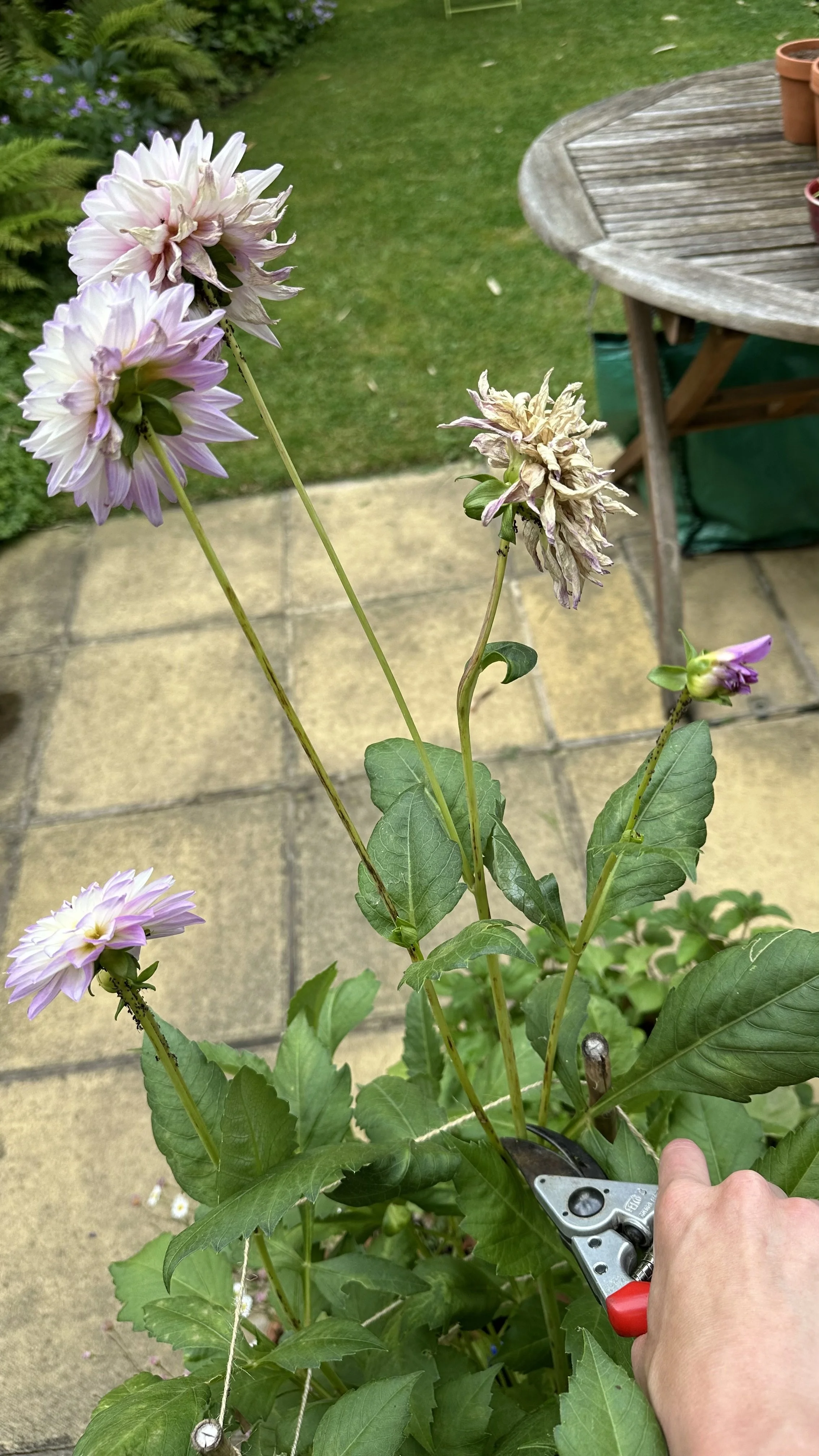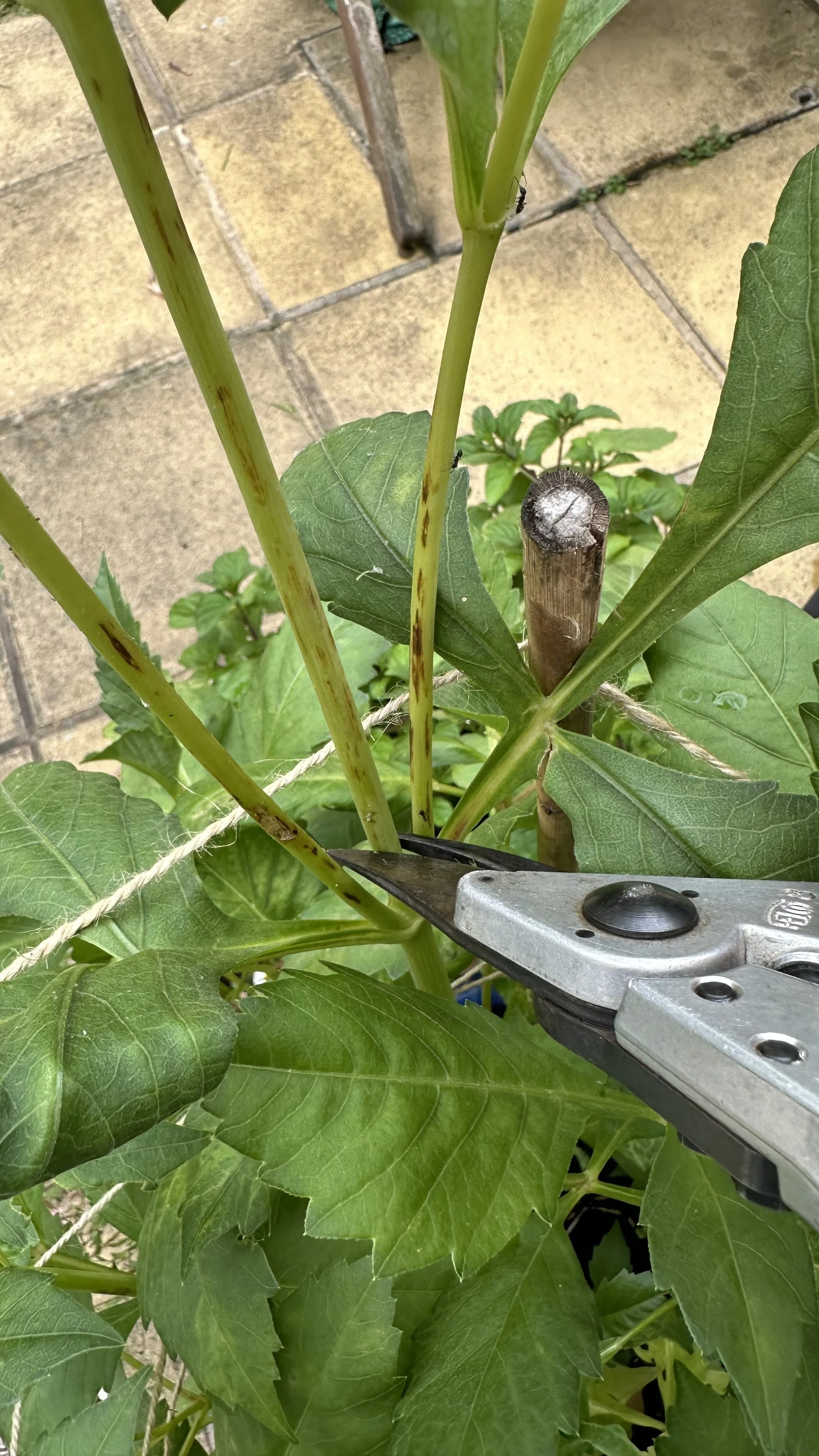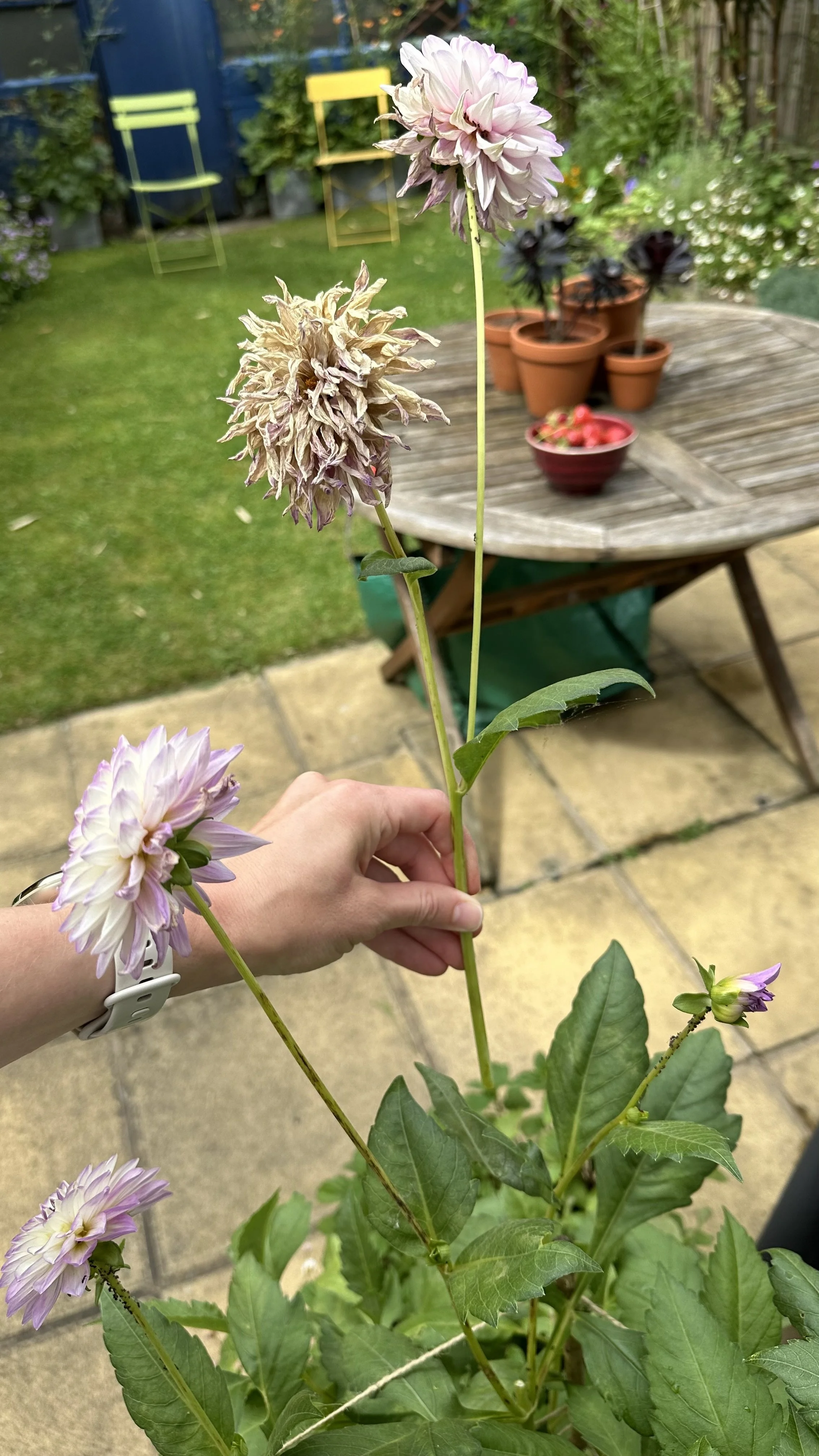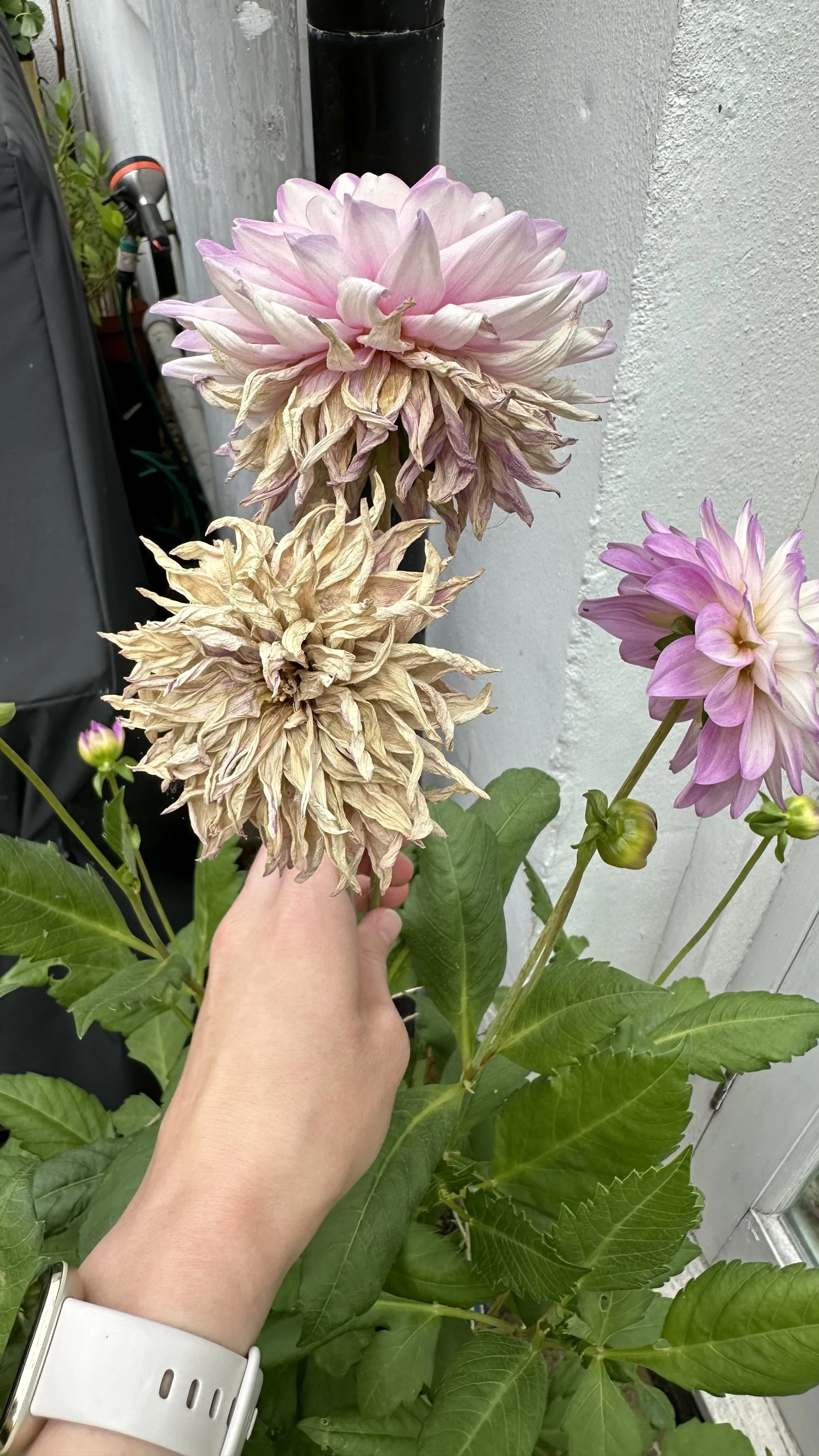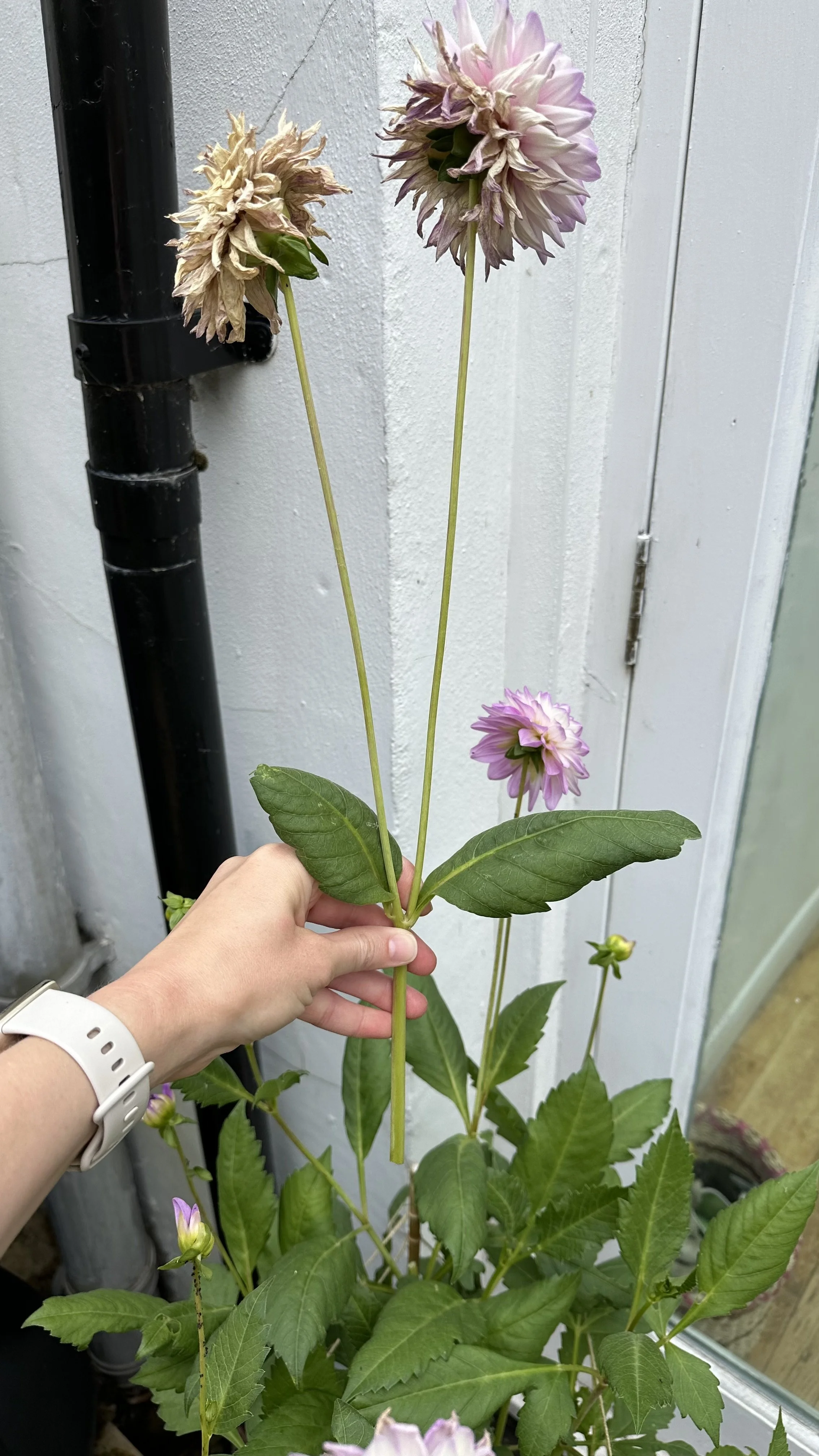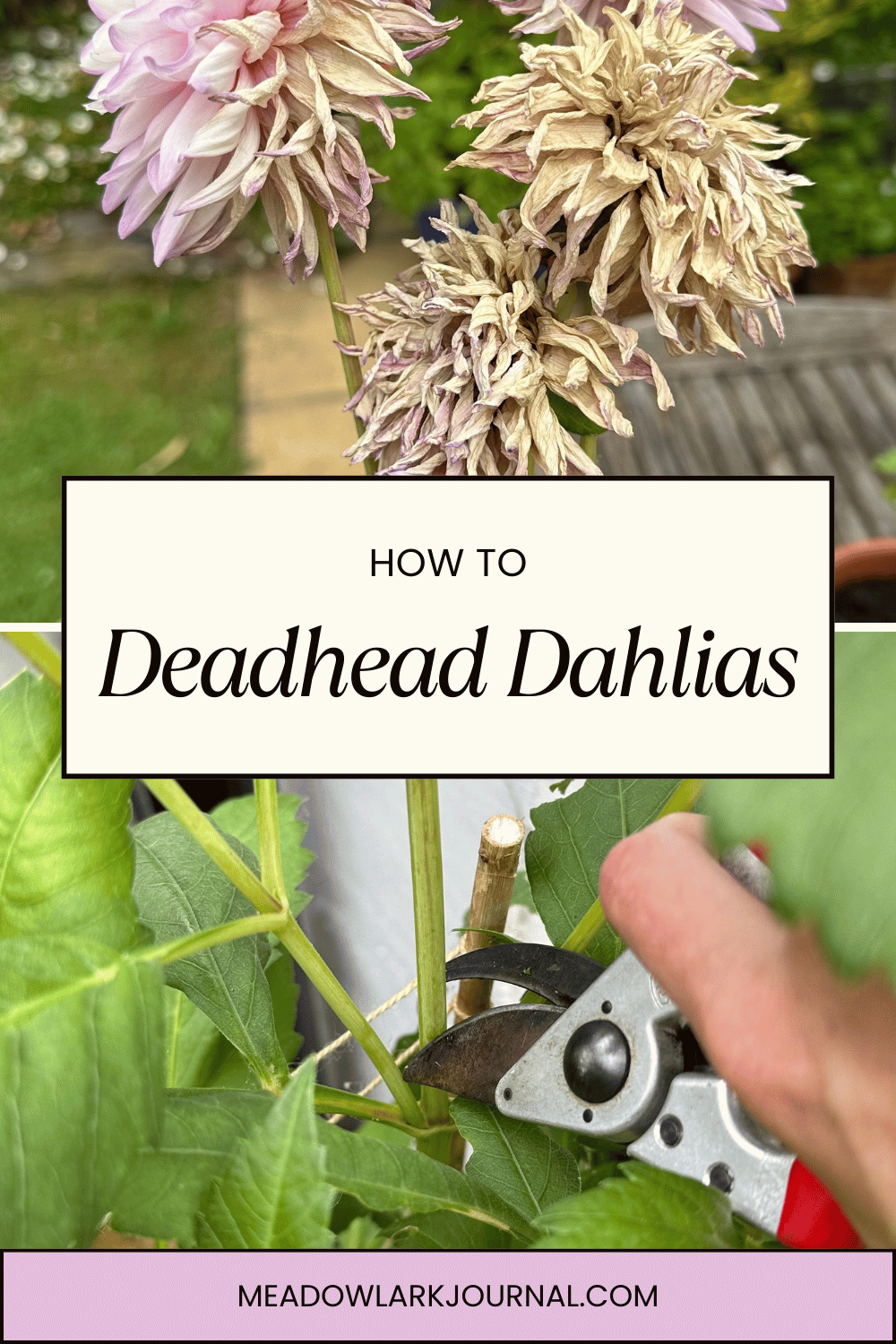How to Deadhead Dahlias for Stunning Blooms
This website is reader-supported - thank you! This post may contain affiliate links. As an Amazon Associate, I earn from qualifying purchases at no extra cost to you.
Mastering the art of deadheading, a crucial aspect of dahlia care, can transform your garden.
This guide is designed to equip you with all the knowledge you need to keep your dahlias dazzling.
From identifying spent flowers to the actual process of deadheading, and what to do afterwards, I cover it all.
Plus, I'll answer some of the most common questions about dahlia care.
So, let's begin our journey into the world of dahlias and discover how to make them thrive in your garden.
Want to learn more about growing dahlias?
Check out my guides:
What is Deadheading?
Deadheading, in the gardening world, is not just a chore; it's an art of renewal for your plants, particularly for those gorgeous dahlias in your garden.
Think of it as a rejuvenating spa treatment for your flowers.
When we talk about deadheading, we're focusing on the strategic removal of dead or fading flowers from a plant.
Why do this? The reason is twofold.
First, when you remove a spent flower, you're essentially preventing the plant from putting its valuable energy into seed production.
In the wild, this is a plant's natural goal - to reproduce.
However, in our gardens, we want to shift this energy from seeding to more flowering.
By snipping off the old, wilted blooms, you're redirecting the plant's efforts back into creating new, fresh, and vibrant blooms.
The second benefit is aesthetic.
Let's face it, wilted and brown flowers don't make for the most attractive display.
By regularly deadheading, you maintain the beauty and vitality of your garden.
It keeps your dahlias looking neat, tidy, and ever-ready for a surprise visit from the neighbors or those impromptu garden photos.
In the case of dahlias, deadheading is particularly important.
Dahlias are known for their bountiful blooms, and to keep this show going throughout the season, they need a little help.
By removing the spent blooms, you're encouraging the plant to produce more flowers.
It's like giving your dahlias a gentle nudge, saying, "Hey, there's more room to show off your beauty!"
In summary, deadheading is not just a routine task; it's an essential part of gardening that keeps your plants healthy and your garden vibrant.
It’s a simple yet effective way to encourage dahlias to keep blooming their heart out, offering you a spectacular floral display all season long.
Ready for more deadheading in the garden? Check out my guides:
Identifying Spent Dahlia Flowers
Identifying spent dahlia flowers is a key skill in the art of deadheading.
It's like being a flower detective, where you're looking for clues to spot the flowers that have had their moment in the sun and are ready to retire.
Let's break down how to become an expert in spotting these spent blooms.
Observing the Petal Condition:
The most obvious sign of a spent dahlia flower is its petals.
Fresh dahlia blooms are vivid, firm, and perky.
In contrast, spent flowers have petals that are wilted, discolored, or falling off.
If the petals look lackluster, droopy, or have lost their vibrant hue, it's a clear indicator that the flower is spent.
Checking the Flower Center:
With dahlias, the center of the flower can be a tell-tale sign.
In a fresh bloom, the center is usually tightly closed or just beginning to open.
In a spent flower, the center often opens up fully, revealing the structures inside, which can start to look dry or hollow.
Assessing the Flower's Posture:
Fresh dahlias stand upright and proud on their stems.
A spent dahlia, however, may droop or tilt in a way that seems like it's no longer basking in the sun but rather bowing out of the spotlight.
The stem might also start to look weak or bent just below the flower head.
Feeling the Texture:
If you're unsure, gently feel the flower.
A fresh dahlia is usually firm to the touch, while a spent one feels soft, mushy, or brittle.
This tactile check can be especially useful when visual cues are borderline.
Observing the Surrounding Buds:
Often, the state of nearby buds can offer clues.
If there are several tight, new buds around a flower that looks slightly older, chances are that this flower is spent.
The plant's energy is now focused on the new growth.
Each dahlia flower has its own lifespan, which can be influenced by factors like the variety of the plant, weather conditions, and how well it's been cared for.
Regularly walking through your garden and observing your dahlias is the best way to get familiar with their life cycle and to identify when it's time to deadhead.
With a bit of practice, you'll become an expert at spotting the spent flowers, helping keep your dahlias blooming and your garden looking its best.
Want to learn more about growing dahlias?
Check out my guide: Planting Dahlia Tubers: A Comprehensive Guide.
How to Deadhead Dahlias
Deadheading dahlias is a simple yet crucial task to extend the blooming season.
Here's a detailed guide on how to do it effectively:
Timing is Key:
The best time to deadhead is when you notice a bloom starting to fade.
Regular inspection of your dahlias is vital.
Aim to check your plants every few days during peak blooming season.
Tools for the Task:
Equip yourself with a good pair of gardening shears or scissors.
Ensure they are clean and sharp to make a clean cut.
This prevents damage to the plant and potential disease.
Here are the best shears for the job:
Identify the Target:
As we discussed earlier, look for flowers that are wilted, discolored, or visibly past their prime.
Remember, you're looking for blooms that are no longer vibrant.
Make the Right Cut:
Locate the next bud or leaf node:
Trace the stem of the spent flower down to where it meets the first set of healthy leaves or a new budding flower.
Angle your cut:
Make your cut at a 45-degree angle about 1/4 inch above the node or new bud.
This angle helps prevent water from settling on the cut surface, reducing the risk of disease.
Be precise and gentle:
Dahlia stems can be somewhat fragile.
A precise, gentle cut ensures the remaining stem is not damaged.
Handling Blooms in Pots Differently:
Dahlias growing in pots may have less space and resources than those in the ground.
Therefore, be extra vigilant about deadheading to encourage more blooms.
Aftercare:
After you've deadheaded, it's a good time to check the overall health of the plant.
Look for signs of pests or diseases, and consider a light application of fertilizer to give the plant a boost.
Here is the fertilizer I recommend:
Regular Maintenance:
Keep an ongoing schedule for deadheading.
The more consistently you do it, the more your dahlias will reward you with fresh blooms.
Disposal of Spent Blooms:
Dispose of the spent blooms properly.
Don't leave them lying around, as they can attract pests or contribute to disease.
Safety First:
While deadheading, wear gloves to protect your hands.
Equip your urban green space with my recommend top tier tools.
Deadheading Dahlias in Different Seasons
Deadheading dahlias is not a one-size-fits-all task; it varies with the changing seasons.
Each season brings its own set of considerations for the optimal care of your dahlias.
Let's explore how to tailor your deadheading practices as the year progresses:
Spring
Early Growth:
As your dahlias start to sprout and grow in the spring, there's generally less need for deadheading.
Focus on nurturing young plants and preparing them for the blooming season.
First Blooms:
Towards the end of spring, when the first blooms begin to appear and eventually fade, start your deadheading routine.
This early deadheading encourages more robust growth and fuller blooms in the coming months.
Summer
Frequent Checks:
Summer is the peak blooming season for dahlias.
This is when your deadheading routine will be the most active.
Inspect your plants regularly, ideally every few days, as different flowers will bloom and fade at varying times.
Encouraging Continuous Blooming:
Regular deadheading during summer is crucial as it encourages the plant to produce more blooms.
This is when you can really make a significant impact on the continued vibrancy and productivity of your dahlias.
Autumn
Reduced Deadheading:
As the days start to shorten and temperatures drop, dahlias begin to slow their growth.
You'll notice fewer new buds forming, and the blooms may last longer before fading.
Preparing for Dormancy:
Towards the end of autumn, especially after the first frost, deadheading becomes less about encouraging new growth and more about preparing the plants for dormancy.
It’s a good time to clean up the plants and remove any spent blooms that could harbor pests or diseases over the winter.
Winter
Dormancy:
In most climates, dahlias will not bloom during winter.
This is the time when the plants rest, and deadheading is not necessary.
Preparation for Next Season:
Use this time to plan for the next year.
Consider rotating your dahlias' location if possible, and think about any new varieties you might want to add to your garden.
General Tips for All Seasons:
Regular Inspection:
Regardless of the season, keeping an eye on your dahlias is key.
Regular inspection allows you to catch any potential problems early, whether it’s pests, diseases, or just identifying when it’s time to deadhead.
Hydration and Nutrition:
Alongside deadheading, ensure your dahlias are well-watered and fertilized appropriately for the season.
This supports overall plant health and vigor.
Watering your dahlias is a great way to use rainwater collected from a water butt.
To learn more about water butts, check out my guide Water Butts: Sustainable Water Storage for Your Garden.
After Deadheading: What Next?
Once you've finished the task of deadheading your dahlias, there are several important steps to take to ensure the ongoing health and vigor of your plants.
This post-deadheading care is crucial for encouraging continued blooming and maintaining the overall well-being of your dahlias.
Here's what to focus on:
Watering Practices:
Consistent Hydration:
After deadheading, ensure your dahlias receive consistent and adequate water.
Dahlias thrive with a steady supply of moisture, especially during the growing and blooming phases.
For more watering tips, check out my guide: How to Use Watering Globes.
Watering Technique:
Water at the base of the plant to avoid wetting the foliage, which can lead to fungal diseases.
Deep, infrequent watering is more beneficial than frequent, shallow watering, as it encourages deeper root growth.
Here is my favorite watering can for the job:
Fertilizing:
Balanced Nutrition:
Post-deadheading is an excellent time to give your dahlias a little boost with fertilizer.
Use a balanced, low-nitrogen fertilizer to encourage more blooms rather than excessive foliage.
Regular Schedule:
Implement a regular fertilizing schedule, following the product's instructions.
Over-fertilizing can be detrimental, so it's important to find the right balance.
Here is the fertilizer I recommend:
Soil Care:
Pest and Disease Monitoring:
Regular Checks:
Keep an eye out for signs of pests or diseases.
Early detection is key to managing any issues before they become major problems.
Natural Solutions:
Where possible, opt for organic or natural pest control methods to keep your garden ecosystem healthy.
Staking and Support:
Stability for Growth:
Some dahlia varieties, especially the taller ones, will need extra support as they grow.
Staking your dahlias can prevent damage to the stems from wind or the weight of the blooms.
Here are the stakes I recommend:
Planning for Future Blooms:
Rotation of Blooms:
If you have multiple dahlia plants, try to rotate which flowers you deadhead to ensure a continuous display of blooms.
Observation:
Take note of how your dahlias respond to deadheading and other care practices.
This observation can help you fine-tune your approach in the future.
Cleanliness:
Remove Debris:
After deadheading, clear away any fallen petals or leaves to maintain a tidy garden and reduce the likelihood of pests and diseases.
FAQs
Do dahlias come back every year?
Dahlias are perennial in nature, but their ability to come back each year depends largely on the climate.
In regions with harsh winters, dahlias, which are tender perennials, may not survive if left in the ground.
To ensure they return, many gardeners in colder climates lift and store dahlia tubers indoors during the winter.
If you're in a warmer climate with mild winters, dahlias can often be left in the ground and mulched over, where they'll re-emerge in the spring.
Remember, each variety of dahlia may have slightly different resilience, so it's good to check the specifics for the types you are growing.
How long do dahlias last in the garden?
The blooming season for dahlias can be impressively long.
With proper care, these plants can bloom from midsummer right through to the first frost, which in many areas means they can provide color for several months.
The key to prolonged blooming is regular deadheading, adequate watering, and appropriate fertilization.
Also, the planting time and local climate can affect the length of the blooming season.
As we wrap up our journey into the care of dahlias, remember the significance of removing spent flower heads.
This simple act of identifying and snipping away the old to make room for the new is what keeps your garden vibrant.
Each dahlia head you deadhead paves the way for a new dahlia to showcase its beauty.
By cutting back to the next flower stem or budding flower buds, you're not just tidying up; you're setting the stage for continuous blooms.
Ready for more garden inspiration? Check out my guides:
Pin this post to save it for later!


